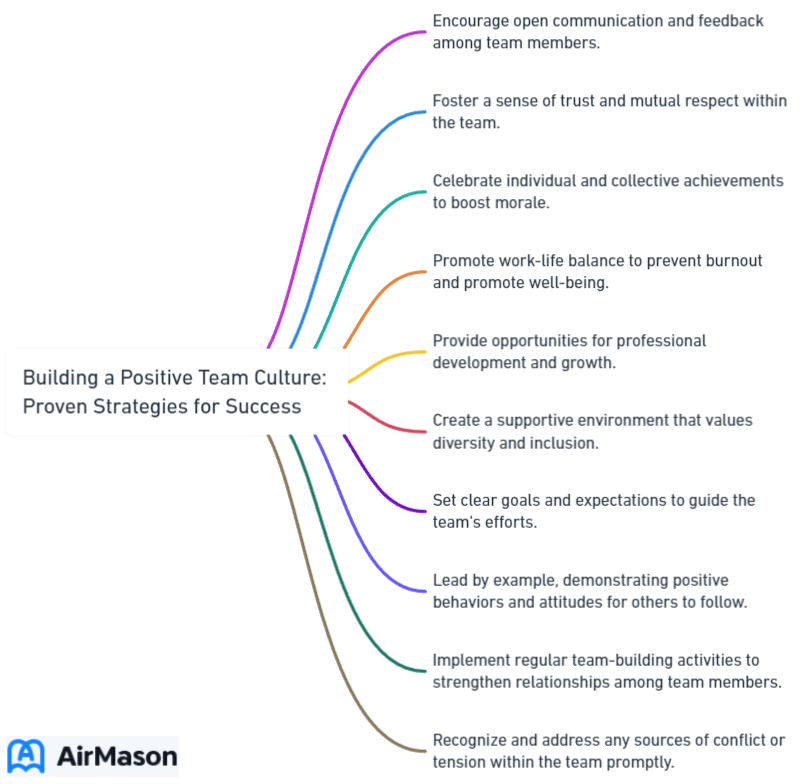
Building a positive team culture is crucial for any organization’s success. But how can you create an environment that nurtures collaboration, fosters open communication, and encourages personal growth in 2024? This blog post will provide you with proven strategies to help you cultivate a thriving team culture that empowers your employees, boosts morale, and ultimately drives your organization’s success.
Key Takeaways
- Establish core values, set expectations and foster open communication to create a strong foundation for positive team culture.
- Encourage collaboration, provide feedback & recognition and promote personal connections & work-life balance to motivate your team.
- Lead by example, embrace change & adaptability and support each other through tough times for successful collective growth!
Establishing a Strong Foundation for Positive Team Culture
Creating a positive team culture requires a solid foundation. Laying the groundwork for a collaborative and supportive environment involves defining core values, setting clear expectations, and fostering open communication, which in turn encourages employees to reach their full potential.
This foundation allows your team members to unite under a common purpose and work together towards shared goals, ultimately contributing to the organization’s success.

Defining Core Values
Collaboratively creating core values is a powerful way to foster a strong and encouraging company culture. Involve your team members in the process by discussing and refining a set of company values that everyone is on board with. Once established, make sure to document and communicate these core values to the entire team.
Demonstrating the importance of these core values by integrating them into daily practices inspires team members to embody them, which strengthens the team culture.
Setting Clear Expectations
Maintaining a positive team culture necessitates setting clear expectations. When team members understand what they need to achieve and how to measure success, they can work more efficiently and effectively. Fostering a positive organizational culture and avoiding misunderstandings can be achieved by implementing the “constant pressure” methodology, which involves regular touchpoints with stakeholders for alignment on goals, timelines, and accountability.
Fostering Open Communication
Fostering trust and collaboration among team members necessitates open communication channels and regular check-ins. Ensuring that updates are consistently shared and making communication a priority allows your team to connect on both a professional and personal level. Encourage team management to reach out and ask employees how they’re doing, and consider organizing regular team meetings for check-ins.
This approach boosts team performance by up to 25% and promotes a positive culture, contributing to a positive organizational culture.
An Organization’s Culture
An organization’s culture encapsulates the collective values, beliefs, and behaviors that shape its identity and define how its members interact both internally and externally. This pervasive element not only sets the tone for day-to-day operations but also significantly influences decision-making processes. It forms the foundation upon which the company’s mission and vision are built, permeating through every level of the organizational hierarchy. An organization’s culture acts as a guiding force, steering employees towards a common goal and fostering a sense of unity and belonging. Moreover, it plays a pivotal role in attracting and retaining talent, as individuals are drawn to environments that align with their own values and principles. A strong and positive organizational culture can be a catalyst for innovation, productivity, and overall success, while a negative culture can lead to discontent, high turnover rates, and ultimately, hindered progress. Therefore, understanding and actively cultivating a healthy organizational culture is paramount for sustained growth and prosperity.
Encouraging Collaboration and Teamwork

Strengthening relationships and enhancing team cohesion involves embracing activities that encourage collaboration, using collaborative tools, and creating a supportive environment. These are crucial elements of a positive team culture, which thrives on teamwork. Investing in these areas not only fosters a positive team culture but also contributes to increased job satisfaction, improved employee performance, and reduced turnover.
Team-Building Activities
Engaging in regular team-building activities is a proven way to connect team members on a deeper level and foster a sense of unity. Organize icebreakers, group activities, and team challenges that promote communication, collaboration, and problem-solving.
These shared experiences help team members to form meaningful connections, creating a cohesive and supportive team environment.
Collaborative Tools
Leveraging collaborative tools like:
- Microsoft 365
- Google Workspace
- Slack
- Miro
- Asana
- Trello
- Podio
- Confluence
can optimize communication and promote teamwork within your organization. Experiment with different apps and platforms to identify the optimal solution for your team, and encourage team input to ensure that everyone is on board and comfortable with the chosen tools.
This approach helps to bridge the gap between team members and fosters a culture of collaboration.
Creating a Supportive Environment
Maintaining a positive team culture necessitates fostering a supportive environment. Ensuring that team members feel comfortable sharing ideas and asking for help involves prioritizing:
- Trust
- Transparency
- Collaboration
- Appreciation
Encourage emotional intelligence among leaders and individuals, as it promotes better communication and collaboration, ultimately resulting in a more productive and successful team.
Developing Leadership Skills for a Positive Team Culture

Inspiring team members to excel in their roles and contribute to a thriving team environment involves being approachable, leading by example, and providing feedback and recognition. These are crucial elements that leaders must embody to shape a positive team culture.
Investing in leadership development ensures that your team leaders, as well as senior leaders, are equipped with the skills and knowledge they need to navigate the challenges of today’s fast-paced business world.
Being Approachable and Available
Approachable and available leaders foster trust and open communication, both essential components of a positive team culture. Make it a priority to be present and accessible to your team, ensuring that they feel comfortable coming to you with any questions, concerns, or ideas they may have.
This approach helps to build a strong team, fostering strong relationships and encouraging collaboration among team members, including their direct reports.
Leading by Example
One of the most powerful ways to shape a positive team culture is to lead by example. Setting a positive example for your team and inspiring them to follow suit involves demonstrating the core values and principles you want to see in your company. Embody the desired values in every action, meeting, campaign, and event, and recognize team members who do the same.
This approach fosters alignment on mission, purpose, and vision, instilling confidence in the face of challenges.
Providing Feedback and Recognition
Promoting team members’ growth and maintaining a positive team culture requires providing constructive feedback and recognition. Here are some tips:
- Deliver criticism in a respectful and helpful manner, focusing on improvement rather than solely pointing out the negative.
- Establish trust and maintain a balance between positive and negative feedback.
- Provide team members with opportunities to learn from their mistakes.
This approach helps to foster a culture of continuous growth and improvement.
Culture of Teamwork
A thriving organization is built upon the foundation of a robust culture of teamwork. This ethos permeates every facet of the workplace, emphasizing collaboration, mutual respect, and collective achievement. In a culture of teamwork, individuals synergize their diverse strengths and talents towards common objectives, transcending personal interests for the collective good. This environment fosters open communication, where ideas flow freely and constructive feedback is valued. Moreover, a culture of teamwork empowers employees, making them feel invested in the success of the team and the organization as a whole. As this culture takes root, it not only drives productivity but also nurtures a sense of belonging and camaraderie among team members, creating a positive and fulfilling work experience.
Promoting Personal Connections and Work-Life Balance

Maintaining a positive team culture involves:
- Fostering personal connections within your team
- Encouraging a healthy work-life balance
- Creating opportunities for team members to get to know each other
- Nurturing collaboration
- Fostering open communication
- Encouraging personal growth
By implementing these strategies to build a positive team, you can create an environment that supports a positive team culture.
Most Experts Agree that Culture Includes the Following Key Factors
When examining the intricate tapestry of human societies, most experts agree that culture encompasses a set of fundamental elements that shape a community’s identity and behavior. Language stands as one of the foremost pillars, acting as a vehicle for communication and a repository of shared knowledge and beliefs. Social norms and customs, another integral facet, establish the accepted behaviors and interactions within a group, offering a framework for social cohesion. Belief systems, whether religious or philosophical, play a significant role in shaping the values and moral compass of a culture, influencing decision-making and ethical considerations. Art and creative expression serve as powerful reflections of a society’s collective imagination, offering insights into its aesthetic sensibilities and emotional landscapes. Finally, material culture, including tools, architecture, and artifacts, provides tangible manifestations of a community’s technological prowess, economic systems, and historical development. These key factors interweave to form the rich tapestry that defines a culture, showcasing the intricate web of connections that bind individuals within a community.
Getting to Know Each Other
Creating opportunities for team members to connect on a personal level can help to build stronger relationships and foster a sense of unity within the team. Some ways to do this include:
- Embrace team culture-building workshops, offsites, and group meetings to encourage team members to share their experiences and interests.
- Provide opportunities for team members to engage in team-building activities, such as team lunches or outings.
- Encourage open communication and collaboration among team members, creating a supportive and inclusive environment.
- Recognize and celebrate individual and team achievements to boost morale and create a positive team culture.
This approach helps to break down barriers and allows team members to form meaningful connections that strengthen the overall team culture.
Encouraging Work-Life Balance
Promoting a healthy work-life balance is crucial for the well-being and satisfaction of your team members. Respect their personal lives by avoiding emails on weekends that demand work or require short turnaround deadlines. Offer resources and support for mental health and wellness to help employees stay balanced and refreshed.
This approach not only fosters a positive team culture but also contributes to a positive work culture, increased job satisfaction, improved employee performance, and reduced turnover for most employees, effectively avoiding the pitfalls of a poor company culture.
Investing in Professional Development and Growth
Maintaining a positive team culture requires investing in professional development and growth. Empowering your team members to reach their full potential and contribute to the organization’s success involves providing learning opportunities, encouraging skill sharing, and celebrating progress and achievements.
Providing Learning Opportunities

Offering learning opportunities enables team members to expand their knowledge and develop their skillset. Prioritize employee training and development programs, and ensure that they address the specific needs of your team members. Provide personalized learning programs, interactive training content, and on-the-job training to help employees acquire new skills and stay on top of industry trends. This approach not only fosters a positive team culture but also contributes to increased job satisfaction, improved employee performance, and reduced turnover.
Encouraging Skill Sharing
Fostering a culture of skill sharing can help to promote continuous improvement within your team. Provide opportunities for team members to learn from each other through mentorship programs, workshops, and seminars. Recognize and appreciate those who share their skills and knowledge, as this helps to cultivate a culture of growth and development.
This approach not only fosters a strong team culture but also empowers individuals to excel in their roles.
Celebrating Progress and Achievements
Recognizing and celebrating progress and achievements can give your team a morale and motivation boost. Acknowledge individual and team accomplishments through recognition programs, awards, and team celebrations. This approach helps to reinforce a culture of success and high performance, ultimately contributing to the organization’s overall success.
Addressing Challenges and Overcoming Obstacles
Constructing a healthy team culture requires facing challenges and conquering obstacles. To build team culture effectively, it’s essential to create a robust and encouraging atmosphere that enables your team to thrive. This involves embracing change, resolving conflicts constructively, and supporting team members through tough times.
Embracing Change and Adaptability
Cultivating adaptability and resilience in the face of change and challenges can significantly benefit your team. Inspire curiosity and learning, champion diversity and inclusion, and establish trust and effective communication to stimulate agility and flexibility.
By creating a safe space for taking risks and making decisions, you lead with passion and commitment to adaptability, granting team members the opportunity to take ownership and collaborate, ultimately unifying them around shared goals and values.
Resolving Conflicts Constructively

Maintaining a positive team culture requires:
- Encouraging open communication
- Constructive conflict resolution
- Addressing conflicts head-on
- Identifying the underlying issues and interests through active listening and open communication.
Generate and evaluate possible solutions by brainstorming potential resolutions and selecting the best one based on its effectiveness, feasibility, and impact on all parties involved. This approach helps to create a resolution that is equitable for everyone and fosters a positive team culture.
Supporting Team Members through Tough Times
Providing support and resources to help team members navigate difficult situations and maintain a positive outlook is essential for fostering a positive team culture. Here are some ways you can offer support:
- Virtual coaching
- Leadership support
- Empowerment
- Team dynamics and collaboration
- Supportive leadership
These resources can help your team members and department heads through challenging times.
Giving your team reassurance and contributing to a positive organizational culture involves being there for them and standing by them when they take a big step.
Summary
In conclusion, building a positive team culture in 2024 is achievable through a combination of establishing a strong foundation, encouraging collaboration and teamwork, developing leadership skills, promoting personal connections and work-life balance, investing in professional development and growth, and addressing challenges and overcoming obstacles. By implementing these proven strategies, you can create an environment that nurtures collaboration, fosters open communication, and encourages personal growth, ultimately driving your organization’s success.
Frequently Asked Questions
How do you develop a positive team culture?
Create a shared understanding of how everyone contributes, foster connections between team members, show empathy, offer help and respect personal lives, set clear objectives, establish team values and promote inclusive practices to develop a positive team culture.
What are the 8 ways to build a culture of teamwork in the workplace?
Creating a culture of teamwork in the workplace starts with building diverse and inclusive teams, clearly defining roles and responsibilities, building trust, encouraging clear communication, giving teams autonomy in decision-making, and managing team meetings wisely – all of which can help to enhance collaboration and productivity.
What is positive team culture at work?
Positive team culture is about cultivating collaboration, trust and employee satisfaction. Leaders create an environment where employees are motivated to do their work, and they trust their team members to make good decisions without constant oversight. Employees in turn feel a sense of accomplishment, meaning and motivation.
How can defining core values benefit my team?
Defining core values can unify and motivate your team, providing a shared set of principles to guide decision-making. This will help foster a strong company culture and encourage positive collaboration.
What are some effective collaborative tools to enhance teamwork and communication?
Collaborative tools such as Microsoft 365, Google Workspace, Slack, Miro, Asana, Trello, Podio and Confluence can effectively enhance teamwork and communication, fostering more productive results in your organization.